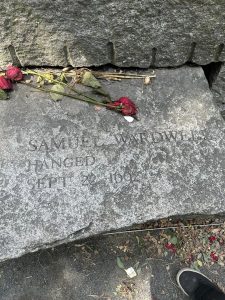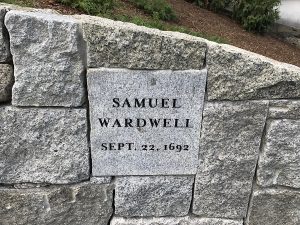I’ve been called a witch often enough. Most of the time, I think that meant the word that started with a “b,” although the term chosen makes no difference to me or my sense of self-esteem. It certainly made a difference my 7th great-grand-dad Samuel Wardwell (1643-1692) and his family, though. Samuel, you see, was in the last group of witches executed in Salem, Massachusetts, in 1692. It was those events that inspired playwright Arthur Miller to write The Crucible in 1953. The same events left that town with a legacy of pilgrimage and Hallowe’en profits.
Samuel Wardwell
I am descended directly from two of Samuel’s children, his son William and his youngest, a daughter, Rebecca. The lines are barely distinguishable. The marriage pool through the 18th century was limited; as I often say, we’re lucky we aren’t born with tails.
Samuel lived with his second wife, Sarah (Hooper) Hawkes in the town of Andover, Massachusetts.[i] She was some 42 years his junior; they married in 1673, blending his son and her daughter from previous marriages and producing six more children. Stacey Schiff[ii] described Samuel in The Witches (2015) as “A feckless fortune-teller and carpenter, at the bottom of the Andover tax lists. Colorfully confesses; later recants. Father of seven.” Apparently he read palms, predicted the genders of unborn babies, and made a number of unwise observations about fellow citizens. Local folk, in any case, appreciated his soothsaying skills.
Arrested, Tried, Convicted
Remember, however, that a host of superstitious and folkloric practices, which one might reasonably describe as “witchcraft,” were integrated into most aspects of daily life in the late 17th century. Religious rites, in that theocratic age, were largely indistinguishable from secular customs in the Massachusetts Bay Colony. The ministrations of clergy frequently resembled such magical thinking.
Samuel apparently confessed to the practice of witchcraft on September 1, 1692. He may have felt he had no choice, given his curses on stray animals who damaged his fields and his various eccentric interests. With Samuel under arrest, the authorities brought in Sarah, her daughter Sarah Hawkes, their eldest daughter Mercy Wardwell, and an infant (presumably Rebecca).[iii] John Higginson, one of the three magistrates involved in the Witch Trials, presided over the hearing and Samuel’s confession. Samuel recanted at his trial on September 14, was convicted, and then hung with five others on September 22.
What About the Kids
The victims of these many arrests for witchcraft that involved multiple members of the same family, were orphaned children. In the Wardwell family, five children consigned to “a suffering condition.” The youngest was a toddler. The court ordered that they should be placed with “good and honest families” but exactly which families, who met that description, were willing to take in the spawn of witches?
The oldest child not accused of sorcery was young Samuel, then sixteen years old. He was sent to live with his uncle John Ballard for one year. Ironically, Ballard was a constable who arrested several of the accused as well as Samuel’s brother-in-law. His wife was Sarah’s sister Rebecca. Ballard had a brother, Joseph, whose wife Elizabeth Phelps Ballard was ailing. Her health had prompted the original accusation against Samuel.
William (a direct ancestor), who was about twelve or thirteen, was put in the home of “Corpl Saml ffrie [Frye] till he come to be of ye age of one and twenty years,” as was to learn ffrie’s trade of weaving. Eliakim, age five, went to Daniel Poor, also until he was twenty-one, and Elizabeth, age two, went to live with John Stevens until she was eighteen. Baby Rebecca (another direct ancestor) was only a year old when her parents were arrested. She stayed, presumably, with Sarah in prison. All of the foster parents were to “find them with suites of apparel att ye end of sd term of tyme” at which point they were apparently on their own.
The Aftermath
Although Sarah was eventually convicted of witchcraft she was not executed. Both Sarah and Mercy, the oldest and half-sisters, were acquitted.
Once the madness of the witch trials subsided, young Samuel petitioned the legislature for redress, compensation for loss of property and income, and for pain and suffering. In 1711, two years after the death of his mother, the legislature determined that the elder Samuel Wardwell was “Wrongly convicted of witchcraft in Salem, MA during what is now known as the Salem Witch Trials.”[iv] Young Samuel was awarded 36£ 15 for both father and mother.
Coincidental Relationships
This narrative includes an ancestral coincidence as well. Elizabeth Phelps Ballard, who died on July 27, 1692 from the illness Samuel was supposed to have caused, was my 8th great-aunt. The Phelps line eventually crosses over into the Greeley family (as did the Wardwell line) and so into my maternal Preston Line. Similarly the Hassell branch—the family massacred by Native Americans in 1691, just a year before the Witch trials—also crosses with the Greeleys. Unfortunate encounters with Indians, however, are a different story.
There are pop-culture connections as well. I share an 8th great-grandfather named Thomas Chandler (1628-1717) with actor Jeff Daniels (b. 1955). I discovered this on the program Finding Your Roots hosted by Henry Louis Gates, Jr.[v] Thomas Chandler was one of the accusers who ultimately sent both Samuel Wardwell and Mary Parker to the gallows. In the case of Mary Parker, Chandler accused her of making Sarah Phelps and Hannah Bigsbee ill. Whatever his grievance with Wardwell, his complaint against Parker was personal. Sarah Phelps was Chandler’s daughter, Sarah Chandler Phelps; Hannah Bigsbee was his granddaughter, Sarah’s niece.
From my point of view, though, it’s all just family history.
In Memoriam
It is not known where Samuel was buried. Records suggest that the group executed that day were buried quickly and carelessly in a shallow mass grave, having first had their clothes replaced with something of lesser quality. Why bury good clothes?
Today, there are a variety of memorials. A small enclosure marks the place at Proctor’s Ledge in Salem where scholars determined that the gallows must have been placed. A space intended to honor all victims of injustice was created by Cutler-Anderson Architects for the Tercentenary of the Witch Trials in 1992 and restored in 2012. It overlooks the Old Burying Ground—which holds the remains of some accusers, judges, and executioners. It is a sobering juxtaposition.
[i] https://salemwitchmuseum.com/locations/sarah-and-samuel-wardwell-home-site-of/
[ii] The hows and whys of the Salem Witch episode, the accusations, motivations, the madness and machinations, are wonderfully explored by Stacy Schiff in The Witches: Salem 1692 (2015). It was in those pages that I was persuaded that the claims of an ancestral victim of the Trials was true.
[iii] The documents associated with the examination and execution of Samuel Wardwell are among the Salem Papers archived at the University of Virginia. https://salem.lib.virginia.edu/n133.html
[iv] http://www.law.umkc.edu/faculty/projects/ftrials/salem/SAL_PET.HTM
[v] January 2023 https://www.youtube.com/watch?v=YDbR9e5tSxk




